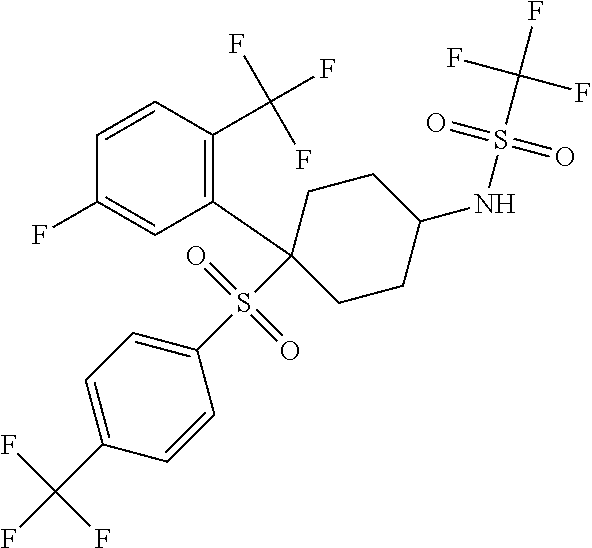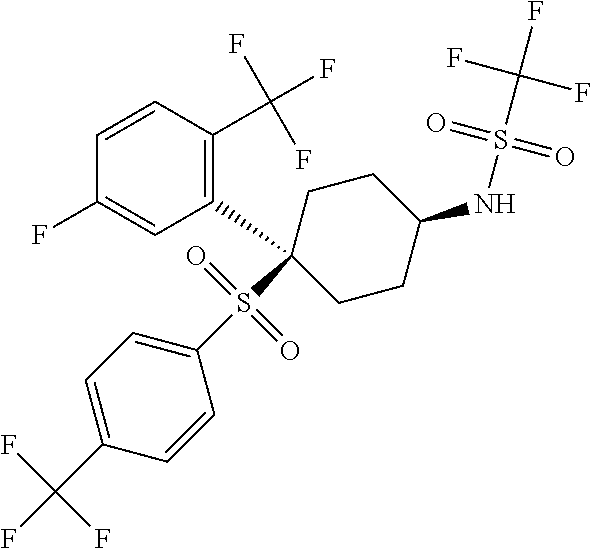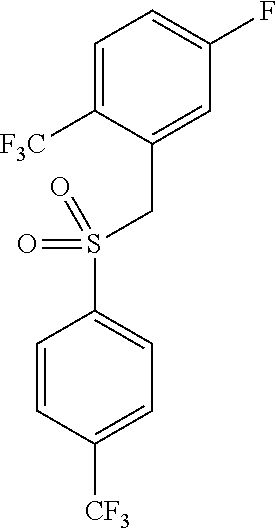Novel trifluoromethylsulfonamide gamma secretase inhibitor
a technology of trifluoromethylsulfonamide and gamma secretase, which is applied in the direction of amide active ingredients, biocide, drug compositions, etc., can solve the problems of gi toxicity in vivo, intestinal goblet cell metaplasia and severe gi toxicity, and unwanted side effects, and achieve favorable pharmacokinetic properties and inhibit the processing of app
- Summary
- Abstract
- Description
- Claims
- Application Information
AI Technical Summary
Benefits of technology
Problems solved by technology
Method used
Image
Examples
synthesis example
Example 1
1,1,1-trifluoro-N-(4-[5-fluoro-2-(trifluoromethyl)phenyl]-4-{[4-(trifluoromethyl)phenyl]sulfonyl}cyclohexyl)methanesulfonamide
Step 1:
[0025]
4-fluoro-1-(trifluoromethyl)-2-({[4-(trifluoromethyl)phenyl]sulfonyl}methyl)benzene
[0026]Sodium sulfite (102 g, 809 mmol) was added to sodium phosphate, dibasic (58 g, 409 mmol) and water (550 ml). 4-(trifluoromethyl)benzenesulfonyl chloride (100 g, 409 mmol) and dioxane (65 ml) were then added to the reaction mixture. The reaction was heated to reflux. After 75 min, the reaction was cooled slightly and a solution of 2-trifluoromethyl-5-fluoro-benzyl bromide (75 g, 292 mmol) in ethanol (95 ml) were added and the mixture was refluxed for 1 hr. The reaction was diluted with water (400 ml) and cooled to 0° C. for 1 hr. The reaction mixture was filtered and the solid was washed with water (2×400 ml) and then with heptane (200 ml). The residue was dried under vacuum to a constant weight and carried to the next step without further purificatio...
example a
[0049]In Rhesus monkeys the PK profile showed a long duration of exposure and extended terminal phase with Example 1 at 30 mg / kg PO single dose: plasma t ½>168 hr, AUC(0-24) 138.2 uM.hr. The average daily CSF Aβ40 reduction was ˜35% relative to baseline, following PO administration of 30 mg / kg over a one week period (168 hrs; 7 days). Peak lowering of ˜46% was observed 24 hrs after each dose. A minimum inhibition of >25% was maintained throughout the duration of sample collection (24 hrs; day 1 to 144 hrs; day 6). Terminal phase pharmacokinetic characteristics of Example 1 in Rhesus monkey provide continuous inhibition over the course of one week achieving both an average as well as minimum reduction of CSF Aβ40 of >25%. Rhesus monkeys showed no unformed stool or other tolerability issues over the course of the study.
example b
[0050]Example 1 was administered orally to rhesus monkeys once-weekly at a dose of 30 mpk and levels of Aβ40 and Aβ42 in the cerebrospinal fluid (CSF) were monitored. Over a 3 week period, average reductions of approximately 40% in CSF Aβ40 and Aβ42 levels were observed, relative to vehicle-treated controls, with no evidence of GI toxicity. (However, the study was terminated after 3 weeks as a result of respiratory side-effects unconnected with Notch signaling.)
PUM
| Property | Measurement | Unit |
|---|---|---|
| temperature | aaaaa | aaaaa |
| temperature | aaaaa | aaaaa |
| particle size | aaaaa | aaaaa |
Abstract
Description
Claims
Application Information
 Login to View More
Login to View More - R&D
- Intellectual Property
- Life Sciences
- Materials
- Tech Scout
- Unparalleled Data Quality
- Higher Quality Content
- 60% Fewer Hallucinations
Browse by: Latest US Patents, China's latest patents, Technical Efficacy Thesaurus, Application Domain, Technology Topic, Popular Technical Reports.
© 2025 PatSnap. All rights reserved.Legal|Privacy policy|Modern Slavery Act Transparency Statement|Sitemap|About US| Contact US: help@patsnap.com



